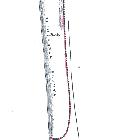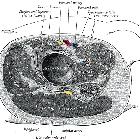Musculus gemellus superior




The superior gemellus muscle is a small triangular muscle in the gluteal region that together with the inferior gemellus and obturator internus muscles form the tricipital (three headed) triceps coxae which occupies the space between the piriformis muscle (superiorly) and quadratus femoris muscle (inferiorly). Together these muscles act primarily to laterally rotate the extended thigh and are also hip stabilizers steadying the femoral head in the acetabulum.
Summary
- origin: gluteal surface of the ischial spine
- insertion: middle part of the medial aspect of the greater trochanter of the femur (also known as the trochanteric fossa)
- innervation: nerve to obturator internus
- action:
- laterally rotates extended thigh
- aids abduction of flexed thigh
- hip stabilizer (helps steady femoral head in acetabulum)
Gross anatomy
Origin
The base of the superior gemellus muscle originates from the gluteal surface of the ischial spine, a thin pointed eminence that emerges from the posterior border of the ischium (the sacrospinous ligament is attached to the point of the ischial spine).
Insertion
The superior gemellus muscle travels almost horizontally to insert in to the middle part of the medial aspect of the greater trochanter, known as the trochanteric fossa, which is a smooth faceted area of bone bounded posteriorly by the intertrochanteric crest. The obturator muscles and both gemelli insert in the trochanteric fossa.
Relations
The superior gemellus muscle lies directly inferior to the piriformis muscle and above the obturator internus muscle. The superior and inferior gemellus muscles are closely related to the obturator internus muscle.
Blood supply
The superior gemellus muscle receives its blood supply from branches of the inferior gluteal artery.
Innervation
The superior gemellus muscle is innervated by the nerve to obturator internus (L5, S1, S2), a branch of the sacral plexus. The nerve exits the pelvis via the greater sciatic foramen inferior to the piriformis muscle and typically between the posterior cutaneous nerve of the thigh and the pudendal nerve. It supplies a small branch to the superior gemellus muscle before continuing to pierce the medial surface of the obturator internus muscle.
Action
The small gemelli are narrow triangular extraperitoneal muscles that may be considered as reinforcements of the obturator internus muscle. In isolation the superior gemellus muscle is incapable of independent action however working synergistically with other external rotators of the hip, the muscle aids lateral rotation of the hip when the thigh is extended and supports abduction when the thigh is flexed. The muscle also helps stabilize the hip joint.
Siehe auch:
und weiter:

 Assoziationen und Differentialdiagnosen zu Musculus gemellus superior:
Assoziationen und Differentialdiagnosen zu Musculus gemellus superior:

